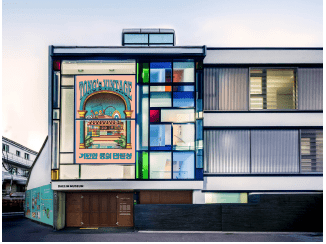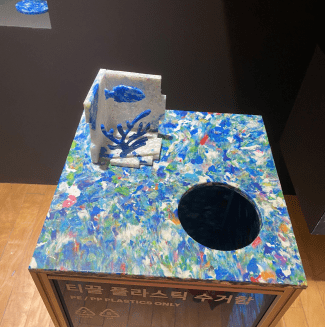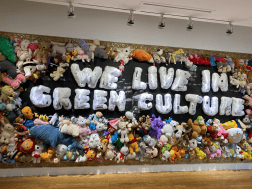Hannah Kim
Tong’s Vintage
The three Rs are becoming more and more essential as time passes. Tong’s Vintage, an art exhibition located in Daelim Museum, South Korea, does a great job of showing why and how we should reduce waste. The exhibition consists of artwork by 23 Korean artists willing to show how they utilize waste in their daily lives. The image below shows what the museum looked like from the outside.

The museum is divided into several sections: Gorgeous Glass, Playful Plastic, Irony Iron, Fabulous Fabric, Wonderful Wood, Painted Paper, and Magical Material. There are three floors, and each of them is organized differently depending on the material used. I personally enjoyed looking at
 the diverse styles as I went through each section. Besides the visible change in style, each exhibition section began with text describing what that particular section was about. The text gave me the context of what I would see and helped me observe the artwork more carefully. Overall, the art show did not have any music, but I could hear conversations that others had, as this exhibition was a very casual and open space. The show itself feltvery light and welcoming even though the meaning behind it was profound. These are some images of the exhibition. The first one is a plastic waste can that was created from melted plastic. Audiences were able to put plastic bottle caps in the waste can so that the artist can use them for their future pieces. I really liked how there were these types of interactive works where the viewers can also feel like they played a role in saving the environment. As you can probably tell from the images, many pieces were made from items that we can easily find in our daily lives.
the diverse styles as I went through each section. Besides the visible change in style, each exhibition section began with text describing what that particular section was about. The text gave me the context of what I would see and helped me observe the artwork more carefully. Overall, the art show did not have any music, but I could hear conversations that others had, as this exhibition was a very casual and open space. The show itself feltvery light and welcoming even though the meaning behind it was profound. These are some images of the exhibition. The first one is a plastic waste can that was created from melted plastic. Audiences were able to put plastic bottle caps in the waste can so that the artist can use them for their future pieces. I really liked how there were these types of interactive works where the viewers can also feel like they played a role in saving the environment. As you can probably tell from the images, many pieces were made from items that we can easily find in our daily lives.

All of the artworks really inspired me to make art out of materials that I do not need, and I could tell many other people were also surprised by how an unexpected item can be reused in art.
The exhibition itself was completely free; however, there was one task to watch the art show. The task was to upload a photo of how we reduce, reuse, and recycle on any social media platform. I posted an image of my stainless steel tumbler that I use when ordering any drinks at a coffee shop. I believe this is really meaningful because, through this activity, we get to spread awareness of saving our environment to others and the opportunity to watch the exhibition.
I do not think they had a lot of staff (maybe one or two per floor), but I personally liked it that way because I always felt that I could not fully observe the artwork with someone watching me.
 Because of the amount of free space, many people took photos of artwork and themselves to post their experiences on social media. Honestly, it was hard to see what I have learned in class because none of the artworks were on sale for this exhibition. As a non-profit organization, I could clearly tell that all artists were focused on spreading the message rather than selling their artworks. However, there was a merchandise shop on the first floor with products like pencil cases and bags made from recycled material. They organized it to have access to the shop after going through the exhibition, and people were more interested in the products because of everything they had seen previously. The products were not very expensive, and it did a great job advocating the three Rs.
Because of the amount of free space, many people took photos of artwork and themselves to post their experiences on social media. Honestly, it was hard to see what I have learned in class because none of the artworks were on sale for this exhibition. As a non-profit organization, I could clearly tell that all artists were focused on spreading the message rather than selling their artworks. However, there was a merchandise shop on the first floor with products like pencil cases and bags made from recycled material. They organized it to have access to the shop after going through the exhibition, and people were more interested in the products because of everything they had seen previously. The products were not very expensive, and it did a great job advocating the three Rs.
Overall, I had a delightful experience with my mother, who accompanied me to the museum. As a rising senior working on their portfolio, I was greatly inspired by the artworks I saw at the exhibition. It helped me know what today’s critical issues are and
how artists can show the message through art. I definitely think I will revisit Daelim Museum for their next exhibition because Tong’s Vintage was up until July 25th. Having seen many of their previous productions, Daelim Museum seems to impress me with their work every time I go. If you are willing to come to South Korea after the pandemic, I certainly recommend taking a look at this museum.